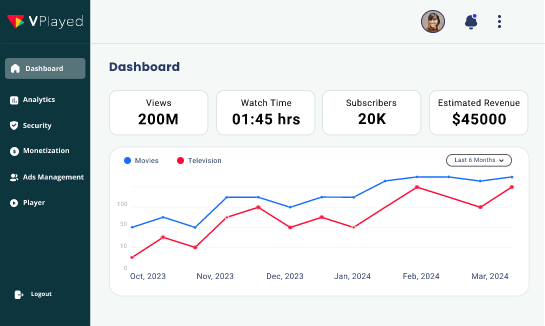10 Anti-Piracy Measures Broadcasters Should Implement for Secure Video Delivery

The stats might intimidate you, but, the fact is – by 2022, video piracy might cost the global OTT platform economy a whopping USD 52million and the number is only going to rapidly peak in the coming years if digital loopholes aren’t cemented.
Revenue loss is a serious threat to the survival of a streaming service and cannot be afforded to be taken lightly.
Of course, security protocols and access measures can be put in place for secure video delivery, but it is how well you reinforce them that can protect your OTT content from prying eyes.
Table of Contents
How Can Security Patch OTT Streaming Loopholes?
The world is evolving immensely in terms of digital growth. But, with an increase in technological advancements also comes a significant rise in piracy, hacking, and video attacks.
Also, did you know that pirated content has over 230 billion views with TV shows, movies, and web series being the most videos watched illegally?
Some of the downfalls OTT services face due to piracy include
- Loss in revenue
- Compromised ownership
- Devalued content
- Slipped reputation
- Declined viewership
- Dropped subscriptions
These are the reasons why OTT players ought to prioritize security before anything else while launching a streaming service that is intended to perform against all odds.
List of Best Practices for Secure OTT Video Delivery
1. Exercise Domain Control
Imposing domain control is the first and foremost step in ensuring your streams are delivered secure and restricted from playing on unauthorized websites.
In other words, you can limit your videos to play only on a list of trusted domains.
So, even if a hacker tries to embed the video on a prohibited site, there is no way anyone can watch it because of the restriction administered.
2. Impose Geographical Restrictions
A similar logic applies when it is specific geography you want to forbid access to.
This is quite a common practice when it comes to streaming regional content that is intended for viewers of a certain region.
Geo-blocking can be enabled at the content level or the entire platform (website or app) can be restricted from appearing in countries not whitelisted using attributes like IP addresses, or email addresses.
3. Foster Token-Based Security System
Token authentication is one of the top security standards that determine whether the user attempting to access the OTT video is authorized for viewing.
It all begins when a viewer clicks the playback button on any particular video – there are two things that can happen now.
(i) In case the server identifies the user as legit, it sends back a unique encrypted authentication token which signals the browser to start the playback. This token expires only when the user logs off and remains active until then.
(ii) On the other hand, a failed verification prompts a message that the user is unauthorized for viewing.
4. Carry Out Software Updates
Software updates might seem trivial from a common man’s perspective.
But, as an OTT platform that strives to combat piracy, using the latest version of streaming formats, plugins, encryption updates, etc can prevent digital attacks from occurring since most of these updates fix vulnerabilities and security loopholes that were identified in the previous version of the software.
5. Setup Secure Payment Processing
The success of a streaming platform not just depends on how well you safeguard your content, it also relies on shielding user information and payment details for reliable transactions.
Especially OTT services that monetize videos ought to be extremely careful about securing the payment gateway with SSL/TLS certificate.
This makes sure every stage of the credit card transaction is encrypted and barred against theft from hackers. This encrypted information is deciphered by the bank that is associated with the payment and the transaction gets through successfully without falling into the trap of trespassers.

6. Embrace Encryption Algorithms
As you can see, the black market of piracy is a serious threat to the content owners of today. Especially, when the videos are transmitted through Internet, a wide spectrum which is easily prone to attacks, tighter security protocols are a must.
AES Encryption – Here, raw video is encrypted to a random junk of numbers that can be deciphered only with a private key from an authorized user.
Any trespasser who tries to view the content that is being transmitted can witness only the encrypted data which is of little use to the digital attacker.
Recommended Reading
7. Use HTTPS for Video Delivery
HTTPS (HyperText Transfer Protocol Secure) plays a major role in keeping your in-transmit video streams from potential attacks. Any video delivered over an HTTPS connection is masked for privacy and ensures authentic transmission of data over the Internet.
OTT platforms use HTTPS for video delivery to
- Restrict alteration of videos
- Maintain the integrity of the content
- Protect from Man-in-the-Middle and phishing attacks
- Add a layer of security through digital certificates and encryption keys
8. Terminate Free Trial Abuse
Free trials are one of the most successful marketing strategies streaming services adopt to acquire subscribers. But, this type of customer acquisition has its downsides too.
Recent surveys reveal that many of the viewers who sign up for a free trial proceed to exhaust the period as much as possible and cancel their subscription right before the trial ends.
Here are some of the ways streaming platforms can curtail free-trial abuse:
- Mandate the user’s phone number
- Track IP addresses
- Install cookies on the viewer’s browser
- Acquire credit card information during sign-up
9. Enlighten Audiences that Piracy is Illegal
Another major reason for growing piracy in recent times is that viewers have begun showing a casual attitude towards watching stolen content.
Users of a large scale either knowingly or unknowingly contribute to content piracy through
(i) Password sharing – One of the most common reasons for streaming services to lose revenue, password sharing with peers has been on the rise.
(ii) Sharing on social forums – Posting clippings or full length of the downloaded videos on social mediums
(iii) Posting on public platforms – Leaking content on discussion forums
Take measures to let your audience know piracy is illegal and is an unethical way to watch your content.
Educate the downsides of streaming content the wrong way whilst highlighting the pros of watching premium content on your platform.
10. Fortify Copyrighted Content
Reproduction of original content is a newer form of piracy that’s been making rounds.
This not only disrupts the originality of the work but also devastates the revenue stream of the content owner, publisher, or distributor.
Especially, in the age of profound social media usage and sharing, secure video delivery has been at stake.
However, by ensuring content distribution via a white-label video platform equipped with DRM (Digital Rights Management tools), the legitimacy of the copyrighted content can be intact, keeping away from replication breaches.
To wrap up,
Secure video delivery is never a one-step process.
It is the adoption of various evolving measures in every course of content production and distribution that makes a streaming platform free from piracy and digital attacks.
In other words, partnering with a mighty and comprehensive streaming suite like CONTUS VPlayed encompassed with advanced security tools, encryption standards, paywall integration, and content protection practices will aid you in piracy-free video delivery to audiences of any scale.

